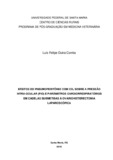| dc.creator | Corrêa, Luis Felipe Dutra | |
| dc.date.accessioned | 2019-08-07T19:55:26Z | |
| dc.date.available | 2019-08-07T19:55:26Z | |
| dc.date.issued | 2016-12-19 | |
| dc.identifier.uri | http://repositorio.ufsm.br/handle/1/17778 | |
| dc.description.abstract | Videolaparoscopic procedures are increasingly gaining ground in the routine of veterinary medicine. In this context, important research projects involving the use of pneumoperitoneum with CO2 and its correlation with possible changes in intraocular pressure (IOP) become more important. This thesis presents a bibliographical survey to contextualize the subject, showing the factors that may influence the IOP (Article 1) and also to verify the influence of three different speeds of pneumoperitoneum with the constant inflation pressure (12 mmHg) and the influence on the cardiorespiratory variables in animals submitted to ovariohysterectomy (OVH) - (Article 2). For the experimental stage, 40 female patients, with an average age of 5 ± 2 months, were selected through clinical, haematological and ophthalmologic examination. Afterwards, they were randomly distributed into four groups, with ten animals each. In G1, the animals were submitted to the videolaparoscopic procedure with inflation rates of 1 l / min; The G2, with a speed of 1.5 l / min and G3, 2 L / min. G4 was called the control group and conventional OVH was performed. The analyzed variables were HR, RR, SAP, DAP, MAP, CVP, ETCO2, SAT and IOP. Patients were evaluated preoperatively (M0) and monitored up to 2 hours after surgery (M1 to M10). The cardiorespiratory variables studied were altered with the presence of pneumoperitoneum, being significant before and after the presence of carbon dioxide (p≤0.005). The effect of between groups was not statistically significant (p> 0.005), and the changes were related to the presence of pneumoperitoneum and the rate of insufflation. The ocular pressures had their increase associated with the pneumoperitoneum and not to the rate of insufflation, as their values stayed within the physiological limits.It was concluded that healthy animals, although they have their intraocular pressure stable when submitted to the pneumoperitoneum with CO2 at the speeds and pressure studied, suffer IOP increase within the physiological patterns after insufflation. | eng |
| dc.description.sponsorship | Coordenação de Aperfeiçoamento de Pessoal de Nível Superior - CAPES | por |
| dc.language | por | por |
| dc.publisher | Universidade Federal de Santa Maria | por |
| dc.rights | Attribution-NonCommercial-NoDerivatives 4.0 International | * |
| dc.rights.uri | http://creativecommons.org/licenses/by-nc-nd/4.0/ | * |
| dc.subject | Cão | por |
| dc.subject | Pneumoperitônio | por |
| dc.subject | Videocirurgia | por |
| dc.subject | Variáveis hemodinâmicas | por |
| dc.subject | Pressão intraocular | por |
| dc.subject | Dog | eng |
| dc.subject | Pneumoperitoneum | eng |
| dc.subject | Video surgery | eng |
| dc.subject | Hemodynamic variables | eng |
| dc.subject | Intraocular pressure | eng |
| dc.title | Efeitos do pneumoperitônio com CO2 sobre a pressão intra-ocular (PIO) e parâmetros cardiorrespiratórios em cadelas submetidas à ovariohisterectomia laparoscópica | por |
| dc.title.alternative | Effects of CO2 pneumoperiton on intraocular pressure (IOP) and cardiorrespiratory parameters in bitches submitted to laparoscopic ovariosalpingohisterectomy (OSH) | eng |
| dc.type | Tese | por |
| dc.description.resumo | Os procedimentos videolaparoscópicos vêm ganhando cada vez mais espaço na rotina da medicina veterinária. Nesse âmbito, tornam-se importantes pesquisas envolvendo o emprego de pneumoperitônio com CO2 e sua correlação com possíveis alterações da pressão intraocular (PIO). A presente tese apresenta levantamento bibliográfico para contextualização sobre o assunto, evidenciando os fatores que podem influenciar na PIO (Artigo 1) e verificar a influência de três velocidades diferentes de pneumoperitônio com a pressão de insuflação constante (12mmHg) e as repercussões sobre as variáveis cardiorrespiratórias, em animais submetidos à ovariohisterectomia (OVH) - (Artigo 2). Para a etapa experimental, foram selecionadas 40 pacientes, fêmeas, com idade média de 5 ± 2 meses, selecionados por meio de exame clínico, hematológico e oftalmológico. Após, foram distribuidos aleatoriamente em quatro grupos, com cada dez integrantes. No G1, os animais foram submetidos ao procedimento videolaparoscópico com velocidades de insuflação de 1 l/min.; o G2, com velocidade de 1,5 l/min. e o G3, 2 l/min. O G4 foi denominado grupo controle, sendo realizada OVH convencional. As variáveis analisadas foram FC, , PAS, PAD, PAM, PVC, ETCO2, SAT e PIO. Os pacientes foram avaliados no pré-operatório (M0) e monitorados até 2 horas após a cirurgia (M1 ao M10). As variáveis cardiorespiratórias estudadas sofreram alterações com a presença do pneumoperitônio, sendo significativas antes e após presença do dióxido de carbono (p≤0,005). O efeito do grupo entre si, não houve diferença estatística (p>0,005), ficando as alterações vinculadas à presença do pneumoperitônio e na velocidade de insuflação. As pressões oculares tiveram seus aumentos associados à execução do pneumoperitônio e não a velocidade de insuflação, ficando seus valores dentro dos limites fisiológicos. Concluiu-se que animais hígidos, embora tenham sua pressão intraocular estável quando submetidos ao pneumoperitônio com CO2 nas velocidades e pressão estudadas, sofrem aumento da PIO dentro dos padrões fisiológicos pós a insuflação. | por |
| dc.contributor.advisor1 | Brun, Maurício Veloso | |
| dc.contributor.advisor1Lattes | http://lattes.cnpq.br/3913050752928325 | por |
| dc.contributor.referee1 | Pippi, Ney Luis | |
| dc.contributor.referee1Lattes | http://lattes.cnpq.br/7254479300721225 | por |
| dc.contributor.referee2 | Stainki, Daniel Roulim | |
| dc.contributor.referee2Lattes | http://lattes.cnpq.br/0445408645323550 | por |
| dc.contributor.referee3 | Silva, Marco Augusto Machado | |
| dc.contributor.referee3Lattes | http://lattes.cnpq.br/2134206254307043 | por |
| dc.contributor.referee4 | Beck, Carlos Afonso de Castro | |
| dc.contributor.referee4Lattes | http://lattes.cnpq.br/9258606189481470 | por |
| dc.creator.Lattes | http://lattes.cnpq.br/0797454601010224 | por |
| dc.publisher.country | Brasil | por |
| dc.publisher.department | Medicina Veterinária | por |
| dc.publisher.initials | UFSM | por |
| dc.publisher.program | Programa de Pós-Graduação em Medicina Veterinária | por |
| dc.subject.cnpq | CNPQ::CIENCIAS AGRARIAS::MEDICINA VETERINARIA | por |
| dc.publisher.unidade | Centro de Ciências Rurais | por |



